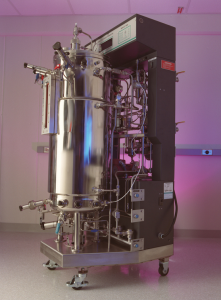
What is Synthetic Biology?
Synthetic Biology is a more extreme form of genetic engineering. Unlike older methods of genetic engineering, synthetic biology techniques give companies greater control over strands of DNA, one of the molecules that carry genetic information. This allows synthetic biologists to create sequences that have never existed before in any organism. Synthetic biology labs effectively treat DNA as a programming language, creating new forms of life that they can then manufacture using a microscopic equivalent of 3-D printing.
Like traditional GMOs, the products of synthetic biology (SynBio) are unlabelled, virtually unregulated and have not been assessed for impacts on our health or environment. Over 117 organizations have called for a complete moratorium on the release and commercial use of this risky new technology until national governments and international bodies have developed adequate precautionary regulations to govern it. The United Nations Convention on Biodiversity has urged countries to handle this technology with caution.
How is synthetic biology different from genetic engineering?
First-generation genetic engineering consisted of combining genes (short sequences of DNA) from different existing species in an attempt to create a combination of those traits. An iconic example of this was the “fish tomato,” where DNA sequences were taken from the winter flounder and placed in the DNA of a tomato in an attempt to make a more frost-resistant tomato. That famous experiment didn’t have the expected results, but Genetically Modified Organisms (GMOs) typically follow the same process: combine DNA sequences from different organisms based on informed guesswork, and see what happens.
Instead of combining existing sequences of genes, synthetic biology techniques attempts to provide genetic engineers with more control over every part of the DNA sequence, treating it much like a programming language. Using computers and machines called DNA synthesizers (which custom ‘print’ strands of synthetic DNA), labs can rapidly generate thousands of new organisms with DNA that has never existed before in the natural world. Synthetic biology labs can also redesign existing organisms by selectively removing or rearranging many parts of a DNA sequence at the same time.
These new techniques have led some to see life as something that can be engineered with exacting precision, using ‘standard parts’ – highly engineered stands of DNA. In synthetic biology lingo, certain bacteria or algae can be used as a “chassis.” For auto manufacturers, chassis (frame, wheels, transmission and motor) are the assembled basic components to make a functional vehicle. The same chassis could be made into a motor home, an ambulance, or a fire truck, depending on the “body” that constructed on it. In the same sense, synthetic biologists approach bacteria like e. coli or certain types of algae as a chassis onto which other functions can be built, reimagining the microbe as a kind of tiny factory. For example, a yeast could be engineered using synthetic DNA to produce fuel oils or vanillin, or a plant could be engineered to glow.
The promise of this way of thinking prompted one scientific magazine to riff (hopefully with tongue in cheek) on the classic broadway character Annie Oakley, declaring: “anything plants can grow…”
Why is synthetic biology dangerous?
It comes down to the potential unknown risks of a poorly understood technology. Commercial synthetic biology labs are creating thousands of new organisms in order to achieve specific outcomes. Once a lab creates a bacterium that eats sugar and produces a certain chemical, it doesn’t mean that the lab understands all the qualities that organism has, it just means that the technicians understand one or a few of its characteristics.
Without extended studies of new organisms that synthetic biologists are creating, we don’t know what other, unintended results might be in play. Regulation is difficult, because we don’t really even know what we’re looking for to evaluate whether synthetic organisms are safe or not.
What are the risks of synthetically modified organisms being released into the environment?

The answer to most questions about the potential effects of synthetic biology is “we can’t yet know,” because the technology is so new. Could a synthetically modified algae designed to produce oil escape into waterways and produce a solar-powered oil spill? Could genes from synthetic organisms transfer themselves into other organisms via bacteria? What would that do to soils and the plants and insects that live there? Could synthetically modified e. coli mutate and exude new and unknown toxins? We don’t know enough to be certain of the answers to any of these questions. Indeed, we don’t know enough to know if they are the right questions.
Environmental release of synthetic algae is of particular concern because algae can spread by both air and water, and can reproduce quickly. Some algae blooms in waterways and the ocean already cause significant environmental problems (eutrophication, production of toxic substances and emissions of greenhouse gases). Algae are also essential to providing most of the oxygen for life on earth and are key to ocean food chains. If a significant change in the genetics of algae somehow took hold in the wild, the consequences could be global.
Most existing synthetic biology companies don’t intend to release dangerous organisms into the wild, and will usually assure us that they’ve taken enough precautions to ensure everyone’s safety. The problem is that without a strong agreed oversight framework in place neither they nor anyone else know enough about the behaviour of synthetically modified organisms to guarantee containment in a credible way.
But the industry says they’re not releasing anything; doesn’t that mean it’s safe?
Actually some synthetic biology companies are hoping to deliberately release their new organisms into the environment. Proposed applications include using bacteria for environmental cleanup or engineered plants.
Most companies that are currently producing commercial substances are doing so in large vats that are a bit like breweries. One thing we can be sure of is that if synthetic organisms are routinely used in such commercial settings, some will eventually escape – through error or accident or because we don’t yet know the proper handling for true containment.
Thousands of new organisms are being generated, and we don’t understand enough about their qualities to be confident of the precautions necessary to prevent environmental release. There are some existing rules for handling genetically engineered organisms, but no standard procedures or regulations have been established specifically with synthetic biology in mind.
What are the health risks of substances produced by synthetically modified organisms?
The short answer is that we can’t yet know. Could there inadvertently be toxins or allergens contained in the substances that synthetic organisms produce? We don’t know, and governments and scientists haven’t even yet determined what the right questions are to investigate health questions in a precautionary way.
Won’t this make expensive food products cheaper?
The price for consumers of a specific compound may be slightly lower, but it may also not be in the long term. For example, a company that put other suppliers (like farmers) out of business could then raise prices again.
A change in the sticker price of a particular commodity is only one of the costs. If hundreds of thousands of farmers lose their livelihoods and consequently stop taking care of their land, effectively ceding their place to industrial agriculture, those are also major costs — even if they are hidden from the consumer. That’s why buyers are paying attention to how wealth and power are distributed through the commodity chain, and moving toward fair trade and solidarity economics. Synthetic biology, by contrast, concentrates power in a few corporations and disempowers the people who have a long-term relationship with the land. Control over production moves from farmers’ hands to corporate vats.
When will synthetic organisms be safe to use?
When a new chemical is introduced for commercial use, there are a number of tests that ought to be conducted to determine its effects on plants, animals and human health. Is it carcinogenic? Is it an endocrine disruptor? Does it bioaccumulate? These are the kinds of questions that we hope governments test for – although still many toxics regulations are inadequate. The tests are the result of some lessons learned the hard way over the 150-year history of synthetic chemistry, sometimes at a great cost to human lives and other species.
Synthetic biology may be even more disruptive than synthetic chemistry, and it will take a great deal of cautious observation of synthetic organisms to develop a similar framework for testing and analysis. Until that framework exists, many organizations, including the UN Convention on Biodiversity, are counselling a precautionary approach.
Is Ecover or Method already using SMOs?
No. They have announced their plans, but to our knowledge they have not yet released a product containing oil from synthetic algae. Ecover had originally said they intended to use synthetic Algae oil as up to seven per cent of their laundry liquid by August 2014. It is unclear whether those timelines are still in place.
What are they feeding the algae?
The algae is currently fed using either cane sugar from Brazil or GMO corn from the US.
Isn’t this a solution to the problem of using Palm Oil?

Ecover and Method claim that switching to synthetically modified algal oil is a sustainable choice because it gets away from using palm kernel oil, which is associated with rainforest destruction, workers rights abuses and land grabs. This isn’t true for a few reasons.
1. Palm kernel oil is a minor factor in the expansion of palm oil plantations.
2. Switching to a coconut-only supplier of lauric acid could have the effect that Ecover claims they are achieving with synthetic algal oil.
3. By using algae fed on Brazilian cane sugar, Ecover may still be supporting rainforest destruction and destructive behaviour.
Read the full article on coconut, algal and palm oil to learn more.
Ecover/Method says they’re going to feed their algae with agricultural waste. Won’t that be more ecologically friendly?
Currently, Ecover does not have the technology to feed its synthetic algae with agricultural waste, and that possibility is a few years off. In the meantime they will use oil from algae fed Brazilian sugar and North American GMO corn. If it becomes a possibility, there is not yet any clear evidence that it would be more ecologically sound than using coconut oil, for example. So-called ‘agricultural waste’ is often the same green matter that is returned to agricultural soils to restore fertility and help store carbon. If that green matter is taken to make soap and is not returned to the soil then it may prove necessary to increase fertilizer use on the fields, boosting greenhouse gas emissions.
Why won’t Ecover/ Method just use coconut oil?
In conversation with ETC Group and Friends of the Earth, Ecover admitted that they had the option to switch to coconut oil-derived ingredients instead of using SynBio algae. They claim this would have been a more expensive option based on the prices they received from their existing suppliers. However, lauric acid is only one ingredient among many and Ecover and Method routinely pay higher costs on single ingredients in order to meet ecological criteria on behalf of their consumers. The companies apparently did not explore the option of sourcing from the Philippines, which is the world’s largest producer of coconut oil. Oleochemical producers (which make the ingredients for soap) say they only use coconut oil as a feedstock.
Is Ecover/Method the only consumer brand to use Synthetic Biology-derived ingredients?
No, but they are the first to admit it. In the last two years a number of consumer ingredients derived from Synthetic biology have started to enter foods, cosmetics, fragrances and household soaps. Synthetic biology replacements for moisturisers, vanilla, grapefruit flavouring and the scents patchouli and vetiver are already in consumer products or just about to enter the market. None of these are labelled in the final product as coming from synthetic biology and some are probably even in products that are described on labels as ‘natural’.
In a recent New York Times investigation, companies that are likely to be using SynBio ingredients refused to return calls from the reporter. A recent closed meeting of synthetic biology companies grappled with how to get away with sneaking synthetic biology-derived ingredients into consumer goods such as foods. A key conclusion of that meeting was that companies should not use the term “synthetic biology” but instead talk about “fermentation-derived” ingredients.
Will Ecover and Method still label their products as ‘Natural’?
“Natural” is an important part of Ecover’s branding but it is hard to see how they can justify labelling ingredients sourced from ‘extreme genetic engineering’ as ‘natural’ – indeed synthetic biology is intrinsically synthetic. Some synthetic biology companies have tried to claim that their ingredients are natural because they are products of fermentation, a natural process.
The organisms doing the fermentation, however, are highly unnatural. The question of what “natural” means in consumer product labelling is a very contentious issue right now and subject to many legal cases. If Ecover and Method decide to press ahead with making natural claims for a product with one or more synthetic biology-derived ingredients, they too may get drawn into legal disputes with consumers who could rightly feel misled.
This post is also available in: French

 English
English Nederlands
Nederlands Français
Français